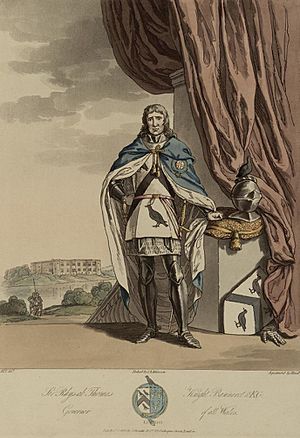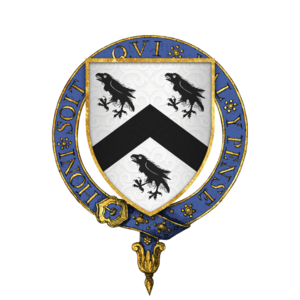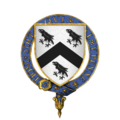Rhys ap Thomas facts for kids
Sir Rhys ap Thomas (1449–1525) was a brave Welsh soldier and important landowner. He became famous during the Wars of the Roses, a big fight for the English throne. Rhys played a key role in helping Henry Tudor win the Battle of Bosworth. He stayed loyal to Henry and was given land and important jobs in South Wales. Some stories even say he was the one who killed King Richard III at Bosworth with his poleaxe.
Contents
Rhys's Early Life
Rhys was the youngest son of Thomas ap Gruffydd ap Nicolas. His family lived in Llandeilo in Carmarthenshire, Wales. His mother was Elizabeth, from Abermarlais.
Around 1460, England was in the middle of the Wars of the Roses. This was a long fight between two powerful families: the House of Lancaster (who supported King Henry VI) and the House of York. Most Welsh landowners supported King Henry VI. This was because his father and grandfather had given them their land for being loyal.
In 1461, when Rhys was about twelve years old, a Lancastrian army from Wales marched into England. This army was led by Jasper Tudor, the Earl of Pembroke. But they lost a battle called the Battle of Mortimer's Cross. Rhys's grandfather, Gruffydd ap Nicholas, was killed in this battle. Soon after, the Yorkists won another big battle, and Edward, Earl of March became King Edward IV.
Some Lancastrians, including Rhys's father Thomas, kept fighting in Wales. Thomas and his brother defended Carreg Cennen Castle. But they had to give up in 1462 after a siege. The Yorkists then damaged the castle on purpose. They did this to stop it from being used as a Lancastrian stronghold again. The lands of the defeated Lancastrians were taken away. So, Thomas and young Rhys had to leave Wales. They went to live in exile at the court of Philip the Good, the Duke of Burgundy.
Thomas and Rhys came back to Wales in 1467. They managed to get some of their old lands back. This was a time when many former Lancastrians got their lands back. They even kept them after King Edward IV won again in 1471.
Rhys's father, Thomas, died in 1474. Rhys's two older brothers had already passed away. So, Rhys inherited all of his father's lands and wealth.
King Richard III's Time
In 1483, King Edward IV died. His son, Edward V, was too young to rule alone. Edward's brother, Richard of Gloucester, took control. He worked with the Duke of Buckingham. They wanted to stop the unpopular relatives of Edward's queen from having power. But Richard went further. He said Edward's children were not rightful heirs to the throne. Then he took the throne for himself. The young Edward V and his brother (known as the Princes in the Tower) disappeared. Many people believe they were killed.
The Duke of Buckingham then turned against Richard. He started a rebellion to bring back the Lancasters. He wanted Henry Tudor, who was living in exile, to be king. But the rebellion failed. Buckingham's army in Wales was stopped by bad storms and floods. His soldiers left him, and he was soon caught and executed. The same storms also stopped Henry Tudor from landing in England.
Rhys ap Thomas had chosen not to support Buckingham's uprising. After the rebellion, King Richard rewarded Rhys. He made Rhys his main leader in southwest Wales. He also gave Rhys a regular payment for life. Richard asked Rhys to send his son to the King's court as a hostage. But Rhys said no. He claimed that his own strong sense of duty was enough to keep him loyal. He supposedly made a big promise to King Richard. He said that anyone who tried to invade Wales where he was in charge would have to do so "over his belly." This meant he would fight them to the death.
Even so, Rhys probably secretly talked with Henry Tudor. Henry was getting ready in France for another try to take the throne from Richard. A doctor named Lewis Caerleon helped them communicate. He was the personal doctor to Lady Margaret Beaufort, Henry Tudor's mother.
The Battle of Bosworth
On August 1, 1485, Henry Tudor sailed from France. He landed in Wales near Dale, close to where he was born. He had a small army of English exiles and French soldiers. At this point, Rhys was supposed to fight Henry. But instead, Rhys joined Henry!
A popular story says that the Bishop of St. David's helped Rhys. The Bishop offered to free Rhys from his promise to King Richard. The Bishop also suggested that Rhys could keep his promise by lying down. Then Henry could step over him. But this might have made Rhys look weak to his men. So, another story says Rhys stood under Mullock Bridge. Henry and his army then marched over the bridge. This way, Henry still went "over" Rhys.
Henry's and Rhys's armies marched separately through Wales. Rhys gathered 500 more men as he went. They met up again at Welshpool before going into England. Rhys's Welsh force was very large. Some said it was big enough to have "wiped out" the rest of Henry's army.
On August 22, they met Richard's army near Market Bosworth. In the Battle of Bosworth, King Richard attacked. His attack was led by John Howard, 1st Duke of Norfolk. A song from that time says Rhys's men stopped this attack. The Duke of Norfolk was killed by an arrow. King Richard then bravely charged directly at Henry. He hoped to kill Henry quickly and win the battle. Henry was knocked off his horse and surrounded.
The poet Guto'r Glyn suggests that Rhys himself killed Richard. He might have used a poleaxe. The poet used a boar, Richard's symbol, saying Rhys "killed the boar, shaved his head." This might mean one of Rhys's Welsh soldiers killed the king. A writer from Burgundy said a Welshman, one of Rhys's men, struck the final blow. Rhys was made a knight right there on the battlefield.
Life After Bosworth
Rhys continued to show his strong loyalty to King Henry VII. He helped stop a rebellion in Brecon in 1486. He also fought against two people who pretended to be rightful kings: Lambert Simnel in 1487 and Perkin Warbeck later. He also helped defeat the Cornish Rebellion of 1497. He even captured the rebel leader, Lord Audeley. For this, he was given the special honor of Knight Banneret.
As a reward for his loyalty, Rhys gained many lands and important jobs in South Wales. He became the Constable of Breconshire and Chamberlain of Carmarthenshire. He was also made Governor of all Wales.
He was also a Privy Councillor. In 1505, he became a Knight of the Garter. This was a very high honor. He celebrated it with a big tournament at Carew Castle in 1507. After King Henry VII died, Rhys remained loyal to his son, Henry VIII. He fought in the Battle of Guinegatte in 1513. He was also one of the Garter Knights who went with Henry VIII in 1520. This was for a famous meeting with the King of France called the Field of the Cloth of Gold.
Rhys was married twice. His first wife was Eva, and his second was Janet. Rhys had many children outside of marriage. But his only legitimate son, Gruffydd ap Rhys ap Thomas, died in 1521. Rhys himself died at Carmarthen Priory in 1525. Later, when Henry VIII closed down monasteries, Rhys's tomb was moved to St. Peter's Church in Carmarthen.
Rhys's lands and jobs were supposed to go to his grandson, Rhys ap Gruffydd. But the Crown took them and gave them to another lord. Rhys ap Gruffydd was later executed by Henry VIII in 1531. This was after he fought the new lord and caused trouble in Carmarthen.
Today, some families claim to be related to Rhys. These include the Lords Dynevor and others in Carmarthenshire.
Images for kids
-
19th-century imaginary portrait of Sir Rhys ap Thomas by John Augustus Atkinson





